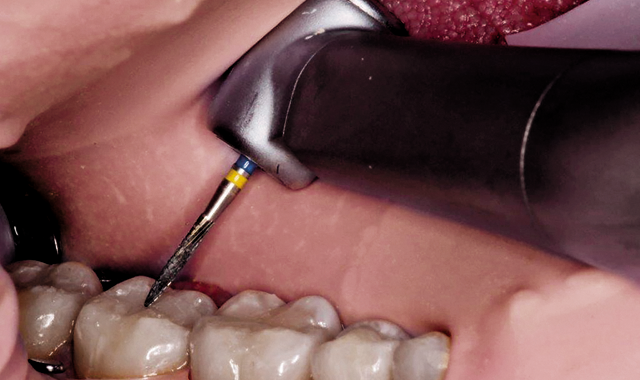How to finish and polish a common composite restoration
Although no two composite restorative procedures are exactly alike, certain everyday finishing and polishing applications can be used in most cases.

Although no two composite restorative procedures are exactly alike, certain everyday finishing and polishing applications can be used in most cases.
Procedural efficiency and esthetic result are the primary objectives for these techniques, and, when paired with predictability and reliability, they become invaluable components of good dentistry.
Proper tooth preparation is the foundation for a beautiful composite restoration. Komet inlay/onlay burs (such as 845KR.FG.025 and 845KR.FG.018) offer ideal options for everything from simple occlusal preparations to multi-surface preparations, yielding even axial walls and pulpal floors and level boxes for seamless placement of composite filling materials. These burs can be used following caries removal with a 5835.FG.012 carbide, as well as after amalgam removal.
Technique: Composite finishing and polishing with Q-Finisher® carbides and CompoBrite™ polishers
Used together, Q-Finishers® and CompoBrite™ polishers quickly and effectively finish and polish composite restorations, saving time and multiple instrument changes while imparting a brilliant high shine to composite surfaces. Once the proper anatomy has been established with Q-Finishers, light-pink CompoBrite polishers are used for prepolishing, followed by the light-yellow polishers, which produce a natural-looking, high shine, glossy finish. The polishers are available in disc, cup, and flame shapes for easy access to all tooth surfaces.
The following case demonstrates finishing and polishing of a common composite restoration using Komet’s Q-Finishers and CompoBrite polishers.
Continue reading on Page 2 ...
Case
1. Place a rubber dam to provide proper isolation and to facilitate a clean working field.
2. Use a 5835.FG.012 followed by 845KR.FG.012. Note: The cleaner the lines, the easier it is to reach the esthetic and functional goal.
3. If the cavity preparation requires it, use a matrix system to prevent open margins and achieve tight contacts. Matrix options range from a traditional Tofflemire to newer sectional systems, such as Palodent® Plus (DENTSPLY). Note: Use of an appropriate matrix is helpful in preventing open margins and achieving tight proximal contacts.
4. Once the matrices are in place, use a chlorhexidine scrub to disinfect the surface prior to bonding.
5. Place etchant followed by bonding resin.
Technique: How to shape and clean root canals with Komet® endodontic instruments
6. Place a layer of flowable composite, such as Tetric EvoFlow® (Ivoclar), and follow with a layer of condensable composite, such as Tetric EvoCeram® (Ivoclar). Note: Layering flowable composite facilitates full coverage for both single- and multi-surface fillings. In addition, the conservative use of materials paired with a respect for natural tooth contours enhances the efficiency of finishing and polishing procedures.
7. Use hand instruments to sculpt the composite to the proper tooth anatomy.
8. Using the Q-Finisher® kit from Komet USA, begin the finishing procedure to establish proper tooth anatomy. Make the initial reduction before removing the rubber dam.
9. Remove the rubber dam, use articulating paper to highlight occlusal contacts, and perform occlusal reduction with the football-shaped H379Q.FG.018 bur.
Related reading: Komet USA debuts new bone cutter at IDS 2015
Continue reading on Page 3 ...
10. Once the proper bite relation has been established for both intercuspal position (ICP or centric) and eccentric occlusion, use the H48LQ.FG.012 to shape detailed anatomy.
11. For a natural-looking and -feeling polish, the two-step CompoBrite system is used.
12. The pink polisher is followed by the yellow polisher to achieve a superior esthetic result.
13. The final restoration demonstrates ideal form and a natural finish.
Today’s dentistry offers a wide variety of techniques and products to meet the needs of every dental-care provider and patient. Good dentistry relies on numerous factors, among which are operator comfort with a particular system or technique, instrument reliability, patient comfort and satisfaction and predictable outcomes. As we continually work toward becoming experts in efficiency and quality to best serve and care for our patients, instrument systems such as the Q-Finishers and CompoBrite polishers are invaluable additions to the practice of good dentistry.
Watch a video of the technique below:
Technique: How to create optimal root-canal access using Komet specialty instruments
Product Bites – November 10, 2023
November 10th 2023The weekly new products podcast from Dental Products Report is back. With a quick look at all of the newest dental product launches, Product Bites makes sure you don't miss the next innovation for your practice. This week's Product Bites podcast features new launches from Amann Girrbach, DMG, Pac-Dent, and ASI Dental Specialties. [4 Minutes]